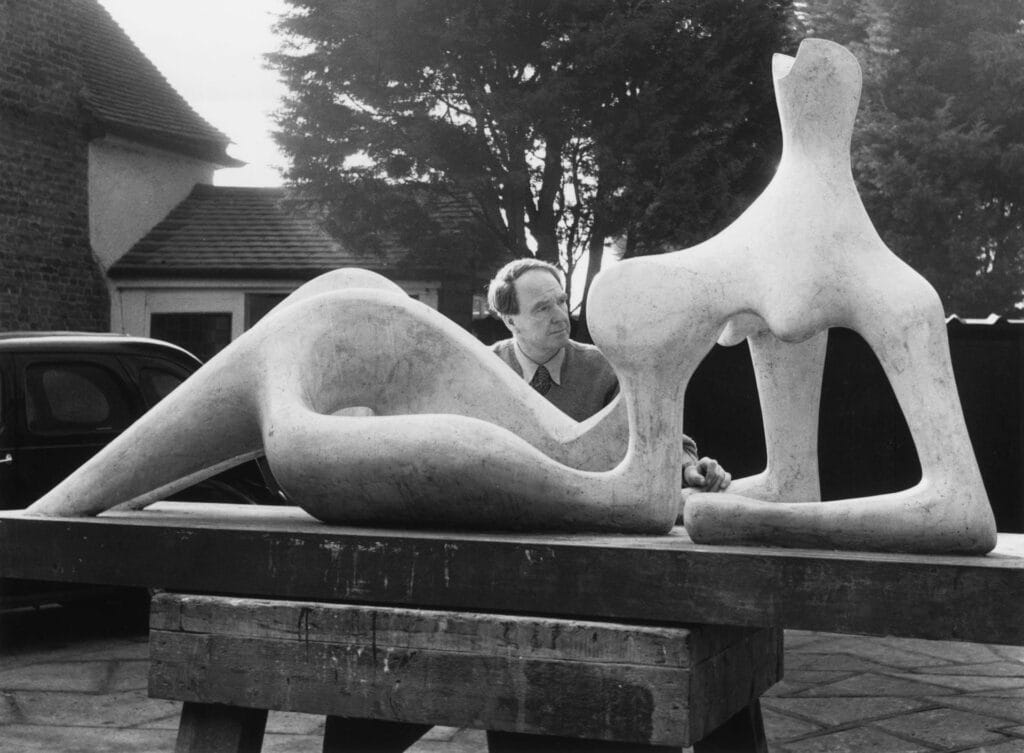“Henry Moore forever changed the course of art history in the 20th century, bravely redefining his style in the post-war period to create wholly new interpretations of the human form. Coming to auction from a distinguished private collection, Reclining Figure: Festival is the undisputed masterpiece of Moore’s career, forever etched in the minds of the British public as one of the triumphs of the 1951 Festival of Britain.”
Oliver Barker, Sotheby’s Chairman, Europe
NEW YORK, 4 OCTOBER 2021 – When Henry Moore’s Reclining Figure: Festival was first unveiled at the 1951 Festival of Britain it caused a sensation, provoking strong reactions among the eight million visitors who attended the festival, helping solidify Moore’s reputation as one of the greatest sculptors of the Twentieth Century. Unveiled today as one of the highlights of Sotheby’s Modern Evening sale, Henry Moore’s Reclining Figure: Festival, is the most significant work by the artist to come to auction and the only cast of the famed ‘Festival’ figure kept by the Moore family, remaining with them for decades before it was acquired by the present owner in 2001. This sale, taking place on 14 November, will mark the first time it will appear at auction, where it could not only achieve a new auction record for the artist but become the most valuable work of British sculpture ever sold.
Widely considered one of the great masterpieces of Henry Moore’s career, Reclining Figure: Festival was commissioned by the Arts Council of Great Britain as the focal point for of the 1951 Festival of Britain, which took place in the newly built South Bank of London. Modelled after the Great Exhibition of 1851, the festival was designed to embody the spirit of British resilience following the privations of war and was seen by many as marking the end of a long period of austerity. It touched all aspects of the creative arts including architecture, textiles, sculpture, painting, science, and literature and today is considered one of the seminal cultural events of British 20th century history.

As a leading sculptor of post-war Modernism and regarded as one of Britain’s greatest living artists, Henry Moore’s commission was highly anticipated, particularly as it was the first time the artist had worked on a monumental scale in bronze – something he was unable to do during the war years. Moore was inspired by his latest experimental sketches capturing singular reclining figures in part inspired by the time he had spent sketching people in the air raid shelters of London’s underground stations during the Blitz.
Knowing that his sculpture would be viewed ‘in the round’ whilst positioned at South Bank, Moore decided to work up his model with the more flexible material of plaster – where he had previously been carving into wood or stone – and then casting it in bronze. Although considered a radical departure at the time, the new materials allowed him to fully explore the balance between solid and void revealing an activation of negative space within the confines of the figure itself. Foreseeing that the work would be a major milestone in his career, he worked with the filmmaker John Read at the BBC to document the process – the first film of a living artist ever made in Britain – which was broadcast not only to coincide with the opening of the Festival of Britain but also his first major retrospective at Tate Gallery held concurrently that year.
Today casts of Reclining Figure: Festival are held in prestigious museum collections including the bronze displayed at the Festival of Britain, which is held by the Scottish National Gallery of Modern Art, Edinburgh, the original plaster at Tate in London, a secondary plaster gifted by the artist to the Art Gallery of Ontario, Toronto, and another bronze acquired by the French State in the 1950s and now in the Centre Pompidou, Paris.
“In the pantheon of 20th century British artists, Henry Moore is at the apex, and Reclining Figure: Festival is indisputably the artist’s greatest achievement. Coming to auction for the very first time, this cast carries a particularly distinguished provenance, having been the only bronze held back by the Moore family following its creation, and kept in just one other private collection since.”
Julian Dawes, Sotheby’s Head of Impressionist and Modern Art, Americas
“Reclining Figure: Festival is Henry Moore’s defining work and one of the most sought-after by collectors around the world. Marking a brave new direction for Moore, this work remains as provocative today as it did when it was first exhibited almost 70 years ago and continues to inspire generations of artists.”
Simon Stock, Senior Director, Impressionist and Modern Art, Europe
Henry Moore’s Landmark Commission For 1951 Festival of Britain,
Reclining Figure: Festival
To Make Auction Debut at Sotheby’s November Modern Evening Sale
Estimated to Achieve in Excess of $30 Million
*The Most Valuable Work by Any British Sculptor at Auction*












